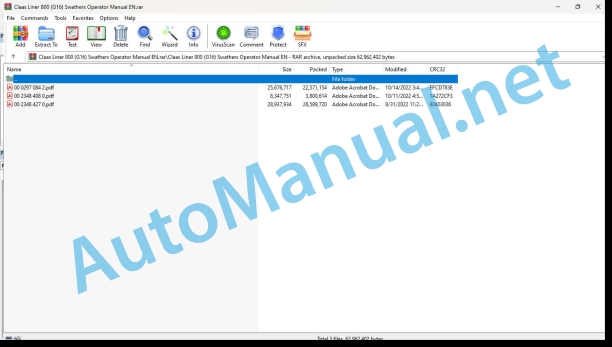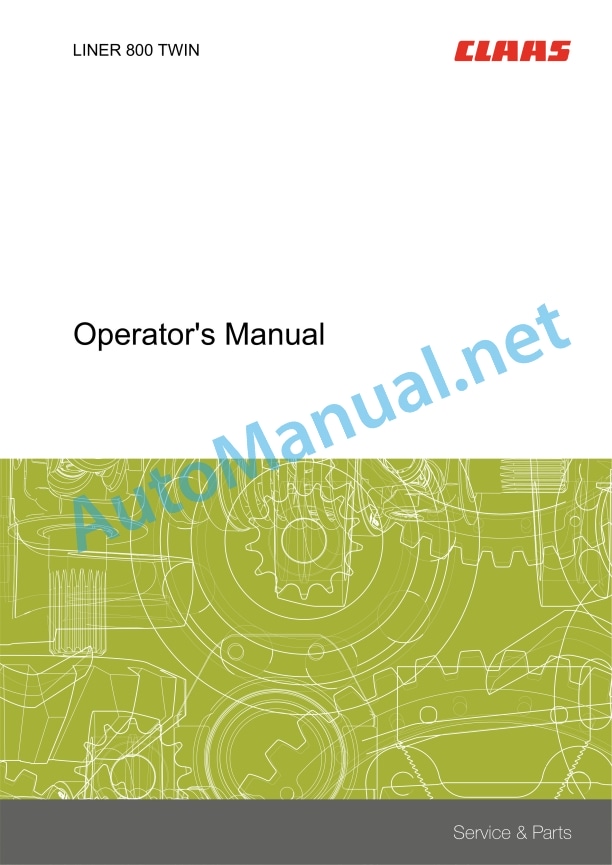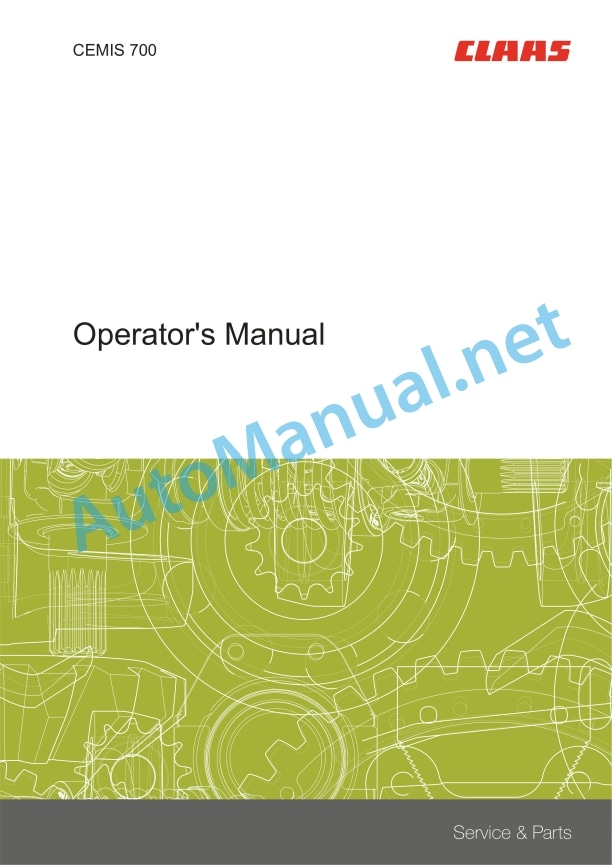Claas Liner 800 (G16) Swathers Operator Manual EN
$50.00
- Model: Liner 800 (G16) Swathers
- Type Of Manual: Operator Manual
- Language: EN
- Format: PDF(s)
- Size: 50.5 MB
File List:
00 0297 084 2.pdf
00 2348 408 0.pdf
00 2348 427 0.pdf
00 0297 084 2.pdf:
LINER 800 TWIN
Table of contents
1 Introduction
1.1 Notes on the manual
1.1.1 Validity of manual
1.1.2 Information about this Operator’s Manual
1.1.3 Symbols and notes
1.1.4 Optional equipment
1.1.5 Qualified specialist workshop
1.1.6 Notes on maintenance
1.1.7 Notes on warranty
1.1.8 Technical specifications
1.1.9 Spare parts and technical questions
1.2 Intended use
1.2.1 Intended use
1.2.2 Reasonably foreseeable misuse
2 Safety
2.1 Identifying warnings
2.1.1 Hazard signs
2.1.2 Signal word
2.2 Safety rules
2.2.1 Meaning of Operator’s Manual
2.2.2 Observing safety decals and warnings
2.2.3 Requirements for all persons working with the machine
2.2.4 Children in danger
2.2.5 Hazard areas
2.2.6 Staying between the tractor and the machine
2.2.7 Hitching the tractor to the machine
2.2.8 Risk of injury from rotating shafts
2.2.9 Structural changes
2.2.10 Optional equipment and spare parts
2.2.11 Control of the machine while it is running
2.2.12 Only use once properly put into operation
2.2.13 Technical condition
2.2.14 Danger resulting from damage to the machine
2.2.15 Respecting technical limit values
2.2.16 Danger from machine parts running on
2.2.17 Keeping the safety devices functional
2.2.18 Personal protective equipment
2.2.19 Wearing suitable clothing
2.2.20 Removing dirt and loose objects
2.2.21 Preparing the machine for road travel
2.2.22 Hazards when driving on the road and in the field
2.2.23 Parking the machine safely
2.2.24 Unsupervised parking
2.2.25 Unsuitable operating materials
2.2.26 Safe handling of operating materials and auxiliary materials
2.2.27 Environmental protection and disposal
2.2.28 Fire prevention
2.2.29 Lethal electrocution from overhead lines
2.2.30 Behaviour in case of voltage flash-over from overhead lines and when lightning strikes
2.2.31 Liquids under pressure
2.2.32 Hot surfaces
2.2.33 Only carry out work on the machine when it is stopped
2.2.34 Maintenance operations and repairs
2.2.35 Raised machine parts and loads
2.2.36 Danger from welding work
2.3 Safety marking
2.3.1 Layout of safety decals
2.3.2 Warning signs on the machine
3 Machine description
3.1 Overview and method of operation
3.1.1 Machine overview
3.1.2 Function of machine
3.2 Optional equipment
3.2.1 Front sensing wheel*
3.2.2 Slip-on yoke, 8-piece*
3.2.3 Hydraulic system connectors, 3-fold*
3.2.4 Hydraulic swathing rubber*
3.2.5 Additional swathing rubber*
3.2.6 Legal technical equipment for the European Union*
3.2.7 Spare wheel, 18.5×8.5-8*
3.2.8 SMV triangle*
3.3 Identification plates and vehicle identification number
3.3.1 Machine identification plate
3.3.2 Machine identification plate
3.4 Information on the machine
3.4.1 Stickers on the machine
4 Operating and display elements
4.1 Controls
4.1.1 Hydraulic hose
4.1.2 Drawbar
4.1.3 Rotors
4.1.4 Swathing curtain
5 Technical specifications
5.1 LINER 800 TWIN
5.1.1 Dimensions
5.1.2 Weights
5.1.3 Requirements for the tractor
5.1.4 Sound pressure level
5.1.5 Version
5.1.6 Tyre size
5.1.7 Tyre pressure
5.1.8 Lubricants
6 Machine preparation
6.1 Switching off and securing the machine
6.1.1 Switching off and securing the tractor and machine
6.1.2 Securing the raised machine
6.2 Adapting the tractor
6.2.1 Checking the protective guard on the tractor PTO shaft
6.3 Adapting the machine
6.3.1 Checking the universal drive shaft length
Shortest working position of the universal drive shaft
Longest working position of the universal drive shaft
6.3.2 Adapting the universal drive shaft length
6.3.3 Fitting the universal drive shaft to the machine
6.3.4 Mounting the linkage drawbar on the drawbar
6.4 Hitching the machine
6.4.1 Removing the safety lock*
6.4.2 Hitching the linkage drawbar up to the machine
6.4.3 Pinning the jack stand in a different location
6.4.4 Installing the universal drive shaft
6.4.5 Fitting the safety chain*
6.4.6 Connecting the hydraulic hose lines
6.4.7 Connecting the lighting cable
6.4.8 Stowing the wheel chocks*
6.4.9 Setting the drawbar height
6.5 Unhitching the machine
6.5.1 Securing the machine against rolling away
6.5.2 Disconnecting the lighting cable
6.5.3 Disconnecting the hydraulic hoses
6.5.4 Removing the universal drive shaft
6.5.5 Disconnecting the safety chain*
6.5.6 Pinning the jack stand in a different location
6.5.7 Unhitching the linkage drawbar from the machine
6.5.8 Attaching the safety lock*
6.6 Prepare road travel
6.6.1 Folding up the swathing rubber
6.6.2 Folding up the hydraulic swathing rubber*
6.6.3 Removing the additional swathing rubber*
6.6.4 Folding the safety frame inwards
6.6.5 Removing the tine bars
Front swathing rotor
Rear swathing rotors
6.6.6 Raising the swathing rotors
6.6.7 Performing checks prior to road travel
6.7 Preparing fieldwork
6.7.1 Lowering the swathing rotor
6.7.2 Installing the tine bars
6.7.3 Fold the safety frame to the outside
6.7.4 Swing the swathing rubber down
6.7.5 Swinging the hydraulic swathing rubber* down
6.7.6 Fit the additional swathing rubber*
6.8 Loading the machine
6.8.1 Lifting the machine
7 Operation
7.1 Driving on the road
7.1.1 Driving on public roads
7.2 Fieldwork settings
7.2.1 Setting the transverse tilt of the swathing rotors
Changing the transverse tilt
7.2.2 Removing the adjustment wrench
7.2.3 Set the swathing rotors in a longitudinal direction
Set the front swathing rotor.
Adjusting the rear swathing rotor
7.2.4 Setting the working height
7.2.5 Adjusting the swathing curtain
Adjusting the swath width
Adjusting the height of the swathing rubber
Adjusting the swathing rubber for single-swath mode
Adjusting the swathing rubber for twin-swath mode
7.2.6 Adjusting the sensing wheel*
7.2.7 Adjusting the hydraulic sequential control
Adjusting the hydraulic sequential control
Adjusting lifting:
Adjusting the lower movement:
7.3 Fieldwork
7.3.1 Switching the machine to transport position
7.3.2 Switching the machine to working position
7.3.3 Adjusting single-swath mode
7.3.4 Double-swath mode
7.3.5 Machine use
7.3.6 Lifting the swathing rotors to the headland position
7.3.7 To be observed during fieldwork
8 Faults and remedies
8.1 Chassis
8.1.1 Changing the wheel on the rotor running gear
8.2 Electric and electronic system
8.2.1 Light bulb faulty
8.2.2 Defective incandescent lamps
9 Maintenance
9.1 Service interval overview
9.1.1 Before the harvest
9.1.2 After the first 10 operating hours
9.1.3 After the first 50 operating hours
9.1.4 Every 8 operating hours or daily
9.1.5 Every 20 operating hours
9.1.6 Every 50 operating hours
9.1.7 Every 500 operating hours or annually
9.1.8 After the harvest
9.2 Gearbox
9.2.1 Checking the gearbox for leaks
9.2.2 Check the oil levels in the main gearbox
Top of main gearbox
Bottom of main gearbox
9.2.3 Change the oil in the main gearbox
Top of main gearbox
Bottom of main gearbox
9.2.4 Check the oil levels in the swath gearboxes
9.2.5 Change the oil in the swath gearboxes
9.2.6 Retighten the bolts on the swath gearbox
9.3 Clutches
9.3.1 Checking the overload clutch
9.3.2 Cleaning the over-run clutch
9.4 Universal drive shaft
9.4.1 Servicing the universal drive shafts
9.5 Chassis
9.5.1 Check the tyre pressure
9.5.2 Checking the wheel nuts on the rotor running gear
9.5.3 Checking the bolts on the rotor chassis
9.6 Hydraulic system
9.6.1 Hydraulic system maintenance
9.6.2 Checking the hydraulic hoses
9.7 Frame
9.7.1 Checking bolts on the frame
9.8 Rotor
9.8.1 Checking the spring brackets
9.8.2 Checking the tines
9.9 Assembly parts and bodywork
9.9.1 Removing harvesting residues
9.9.2 Clean the machine
9.9.3 Upkeep the machine
9.9.4 Check the fittings
9.10 Lubrication plan
9.10.1 Lubricate greasing points every 8 operating hours
9.10.2 Lubricating grease points every 20 operating hours
9.10.3 Grease all grease points every 50 operating hours
10 Putting out of operation and disposal
10.1 General information
10.1.1 Removal from service and disposal
11 EC declaration of conformity
11.1 LINER 800 TWIN
11.1.1 EC Declaration of Conformity
12 Technical terms and abbreviations
12.1 Terms and explanations
12.1.1 Abbreviations
12.1.2 Technical terms
00 2348 408 0.pdf:
CEMIS 100
Table of contents
1 Introduction
1.1 General information
1.1.1 Validity of the manual
1.1.2 Information about this Operator’s Manual
1.1.3 Symbols and notes
1.2 Intended use
1.2.1 Intended use
1.2.2 Reasonably foreseeable misuse
2 Safety
2.1 Safety rules
2.1.1 General safety and accident prevention regulations
2.1.2 Interaction between terminal and machine or tractor
2.1.3 Electrocution by electrical system
3 Product description
3.1 Overview and method of operation
3.1.1 Overview of CEMIS 100
3.1.2 Function principle of CEMIS 100
3.2 Identification plates and identification numbers
3.2.1 Spare parts and technical questions
3.2.2 Identification plate of CEMIS 100
4 Operating and display elements
4.1 CEMIS 100
4.1.1 User interface for LINER
4.1.2 User interface for ROLLANT
4.1.3 User interface for UNIWRAP
5 Technical specifications
5.1 CEMIS 100
5.1.1 Specification
6 Operation
6.1 CEMIS 100
6.1.1 Operating the CEMIS 100
6.1.2 Switching CEMIS 100 on
6.1.3 Switching CEMIS 100 off
7 Maintenance
7.1 CEMIS 100
7.1.1 Daily
8 Putting out of operation and disposal
8.1 General information
8.1.1 Removal from service and disposal
9 Technical terms and abbreviations
9.1 Terms and explanations
9.1.1 Technical words
9.1.2 Abbreviations
00 2348 427 0.pdf:
CEMIS 700
Table of contents
1 Introduction
1.1 General information
1.1.1 Validity of the manual
1.1.2 Information about this Operator’s Manual
1.1.3 Symbols and notes
1.2 Intended use
1.2.1 Intended use
1.2.2 Reasonably foreseeable misuse
2 Safety
2.1 Safety rules
2.1.1 General safety and accident prevention regulations
2.1.2 Interaction between terminal and machine or tractor
2.1.3 Electrocution by electrical system
3 Product description
3.1 Overview and method of operation
3.1.1 Overview of CEMIS 700
3.1.2 Function principle of CEMIS 700
3.2 Identification plates and identification numbers
3.2.1 Spare parts and technical questions
3.2.2 Identification plate of CEMIS 700
4 Information on the product
4.1 Software version
5 Operating and display elements
5.1 CEMIS 700
5.1.1 User interface
5.1.2 Terminal program
6 Technical specifications
6.1 CEMIS 700
6.1.1 Specification
7 Operation
7.1 CEMIS 700
7.1.1 Operating the CEMIS 700
7.1.2 Switching CEMIS 700 on
7.1.3 Switching CEMIS 700 off
7.2 Terminal settings
7.2.1 Making settings
Making settings with the rotary button
Making settings with the touch function
7.2.2 Setting the screen lighting
Daytime mode
Nighttime mode
Activating automatic key lighting
7.2.3 Setting the time and date
7.2.4 Displaying diagnosis information
On-board power supply voltage display
Display of CLAAS ISOBUS ECU address and name
7.2.5 Setting the language and display formats
Setting the language
Setting display formats
7.2.6 Setting the volume
7.2.7 Deleting an ISOBUS implement
8 Maintenance
8.1 Maintenance
8.1.1 Daily
9 Putting out of operation and disposal
9.1 General information
9.1.1 Removal from service and disposal
10 Technical terms and abbreviations
10.1 Terms and explanations
10.1.1 Technical words
10.1.2 Abbreviations
John Deere Parts Catalog PDF
John Deere Tractors 6300, 6500, and 6600 Parts Catalog CQ26564 (29SET05) Portuguese
John Deere Repair Technical Manual PDF
John Deere Diesel Engines POWERTECH 2.9 L Component Technical Manual CTM126 Spanish
John Deere Parts Catalog PDF
John Deere Tractors 7500 Parts Catalog CPCQ26568 30 Jan 02 Portuguese
John Deere Repair Technical Manual PDF
John Deere Repair Technical Manual PDF
John Deere Repair Technical Manual PDF
John Deere Repair Technical Manual PDF
John Deere Repair Technical Manual PDF
John Deere 16, 18, 20 and 24HP Onan Engines Component Technical Manual CTM2 (19APR90)
John Deere Repair Technical Manual PDF
























